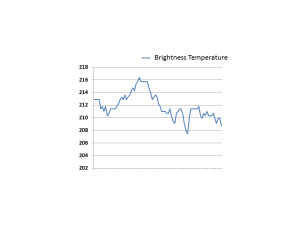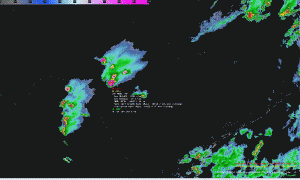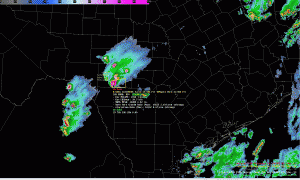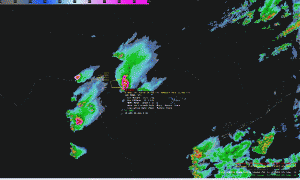Hail-Producing storm over the Texas Hill Country
A hail-producing storm (cick here for Storm reports from SPC) moved through Edwards, Real and Bandera counties of Texas after sunrise on May 9th. This storm gives a nice opportunity to compare ProbSevere and GOES-14 SRSO-R depictions of a severe storm. The 1400 UTC image, above, shows ProbSevere > 95%, with a MESH just over 1″. Within the next 10 minutes, MESH increased to 1.48″ at 1406 UTC (when ProbSevere was 96%), and to 1.92″ at 1408 UTC (see image below, when ProbSevere was 99%). A Severe Thunderstorm Warning was issued at 1408 UTC.
The storm maintained its strength over the following half hour. Imagery from 1436 shows MESH values near 1.50″ and ProbSevere is at 99%. At 1442 UTC, the radar shapefile vanishes from the display, a result of processing errors, but it is back at 1444 UTC. Note that the Satellite Predictors have flipped at 1444 UTC from values derived at 1015 UTC to ‘Mature Storm‘ (this change has nothing to do with the missed processing at 1442 UTC). Recall that ProbSevere is designed to probabilistically determine whether or not a storm will produce severe weather in the next 60 minutes. ‘Mature Storm’ designations serve as a reminder that Probabilities have been elevated for a long period of time.
At 1458 UTC, below, near the end of the Severe Thunderstorm warning, the MESH value that is incorporated into the ProbSevere computation has decreased to 1.17″, and ProbSevere has dropped to “only” 97%. At 1502 UTC, however, MESH has started to increase again, to 1.21″ (and ProbSevere remains high); a second severe thunderstorm warning is issued at 1504 UTC when MESH is at 1.53″ (and ProbSevere is at 99% again). ProbSevere remains high through 1530 UTC.
GOES-14 was in SRSO-R mode during this hail event, allowing an opportunity to see the storm evolution at very high temporal resolution. (The storm initially was right at the edge of the domain). The animation below shows cloud-tops warming around 1440 UTC, before cooling again, consistent with changing updraft speeds that can be inferred by changes in MESH. Cold temperatures occurred at 1501 UTC, 209.1 K. Temperatures were cooler than 210 K only at 1500 and 1501 UTC — that is, for two minutes — demonstrating the importance of 1-minute imagery in resolving without aliasing the coldest features at cirrus level. A second very cold event occurred between 1507 and 1509 UTC (brightness temperatures were cooler than 208 K); it was gone by 1511 UTC (when brightness temperatures were all warmer than 211 K). One-minute imagery is necessary to resolve these very rapid changes at cirrus level.

GOES-14 Visible (0.62 µm) (top) and GOES-14 IR (10.7 µm) (bottom) from 1401 UTC through 1530 UTC on 9 May. Edwards, Real and Bandera Counties are highlighted
The plot below shows the coldest IR Brightness Temperature observed in the GOES-14 10.7 µm channel over the hail-producing storm. Tic-marks along the x-axis are at 5-minute intervals, and there are large differences that occur with time-scales shorter than 5 minutes. This is consistent with the findings of Cintineo et al. in the September 2013 issue of Journal of Applied Meteorology and Climatology (link).

Minimum cloud-top IR Brightness Temperature over hail-producing storm, from 1411-1530 UTC. Tic marks on x-axis every 5 minutes.
During the following hours, 1-minute interval GOES-14 0.63 µm visible channel images (below; click image to play animation; also available as an MP4 movie file) showed other areas of convection which produced damaging winds across parts of southeastern Texas.




